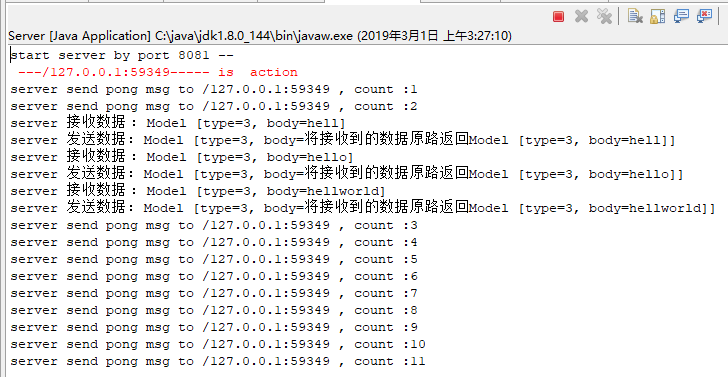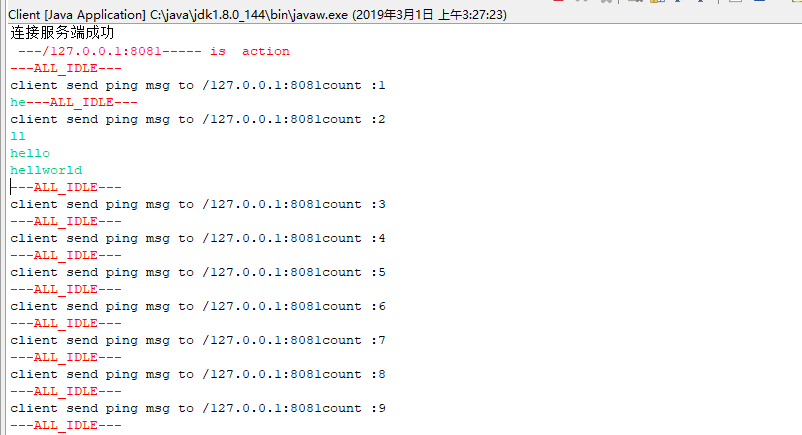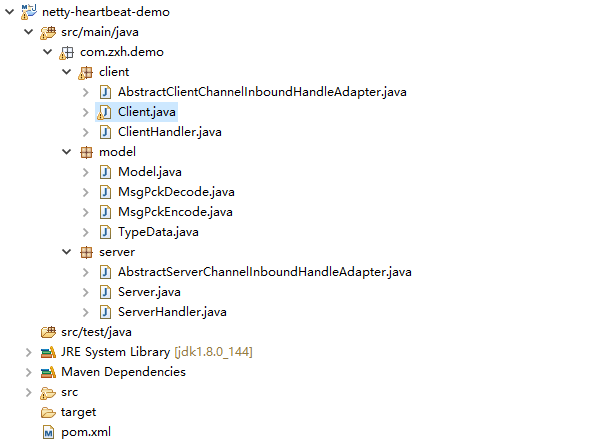基于netty实现的长连接,心跳机制及重连机制
概述
详细
详细
本篇demo实现的功能是基于netty的心跳机制和长连接以及重连机制,最关键的就是通过netty中的 IdleStateHandler 的超时机制来实现心跳和重连 ,然后通过org.msgpack编码器来实现跨平台数据传输,
实现的功能就是通过Scanner来输入消息得到服务端的回应,超过设定的超时时间就触发超时事件来进行心跳传输,如果服务端宕机客户端就会一直发起重连。
一、运行效果
服务端:

客户端:

二、实现过程
在maven pom文件添加依赖:
<!-- 解码and编码器 -->
<!-- https://mvnrepository.com/artifact/org.msgpack/msgpack -->
<dependency>
<groupId>org.msgpack</groupId>
<artifactId>msgpack</artifactId>
<version>0.6.12</version>
</dependency>
<!-- netty 核心依赖 -->
<!-- https://mvnrepository.com/artifact/io.netty/netty-all -->
<dependency>
<groupId>io.netty</groupId>
<artifactId>netty-all</artifactId>
<version>4.1.33.Final</version>
</dependency>导入以上依赖
↓
创建配置模型model(模型类) , TypeData(参数配置类)
↓
创建解码and编码器MsgPckDecode(解码器) ,MsgPckEncode(编码器)
↓
创建各自的控制器 AbstractClientChannelInboundHandleAdapter,AbstractServerChannelInboundHandleAdapter
↓
创建客户端及客户端控制器Client(客户端启动类) , ClientHandler(客户端控制器)
↓
创建服务端以及控制器Server(客户端启动类) , ServerHandler(客户端控制器) ps:本demo使用了msgpack , It’s like JSON. but fast and small.package com.zxh.demo.model; import java.io.Serializable;
import org.msgpack.annotation.Message;
/**
* 消息类型分离器
* @author Administrator
*
*/
@Message
public class Model implements Serializable{ private static final long serialVersionUID = 1L; //类型
private int type; //内容
private String body; public String getBody() {
return body;
} public void setBody(String body) {
this.body = body;
} public int getType() {
return type;
} public void setType(int type) {
this.type = type;
} @Override
public String toString() {
return "Model [type=" + type + ", body=" + body + "]";
}
}编写一个配置类接口,用于控制心跳包和应用消息的处理
package com.zxh.demo.model; /**
* 配置项
* @author Administrator
*
*/
public interface TypeData { byte PING = 1; byte PONG = 2;
//顾客
byte CUSTOMER = 3;
}创建MsgPckDecode(解码器)
package com.zxh.demo.model; import java.util.List;
import org.msgpack.MessagePack;
import io.netty.buffer.ByteBuf;
import io.netty.channel.ChannelHandlerContext;
import io.netty.handler.codec.MessageToMessageDecoder; /**
* 解码器
* @author Administrator
*
*/
public class MsgPckDecode extends MessageToMessageDecoder<ByteBuf>{ @Override
protected void decode(ChannelHandlerContext ctx, ByteBuf msg,
List<Object> out) throws Exception { final byte[] array; final int length = msg.readableBytes(); array = new byte[length]; msg.getBytes(msg.readerIndex(), array, 0, length); MessagePack pack = new MessagePack(); out.add(pack.read(array, Model.class)); }
}创建MsgPckEncode(编码器)
package com.zxh.demo.model; import org.msgpack.MessagePack;
import io.netty.buffer.ByteBuf;
import io.netty.channel.ChannelHandlerContext;
import io.netty.handler.codec.MessageToByteEncoder; /**
* 编码器
* @author Administrator
*
*/
public class MsgPckEncode extends MessageToByteEncoder<Object>{ @Override
protected void encode(ChannelHandlerContext ctx, Object msg, ByteBuf buf)
throws Exception {
// TODO Auto-generated method stub
MessagePack pack = new MessagePack(); byte[] write = pack.write(msg); buf.writeBytes(write); }
}创建client客户端:
package com.zxh.demo.client; import java.util.Scanner;
import java.util.concurrent.TimeUnit; import com.zxh.demo.model.Model;
import com.zxh.demo.model.MsgPckDecode;
import com.zxh.demo.model.MsgPckEncode;
import com.zxh.demo.model.TypeData; import io.netty.bootstrap.Bootstrap;
import io.netty.channel.Channel;
import io.netty.channel.ChannelFuture;
import io.netty.channel.ChannelFutureListener;
import io.netty.channel.ChannelInitializer;
import io.netty.channel.ChannelOption;
import io.netty.channel.ChannelPipeline;
import io.netty.channel.nio.NioEventLoopGroup;
import io.netty.channel.socket.nio.NioSocketChannel;
import io.netty.handler.timeout.IdleStateHandler; public class Client { private NioEventLoopGroup worker = new NioEventLoopGroup(); private Channel channel; private Bootstrap bootstrap; public static void main(String[] args) {
Client client = new Client(); client.start(); client.sendData();
} private void start() {
bootstrap = new Bootstrap();
bootstrap.group(worker)
.channel(NioSocketChannel.class)
.option(ChannelOption.TCP_NODELAY, true)
.handler(new ChannelInitializer<Channel>() {
@Override
protected void initChannel(Channel ch) throws Exception {
// TODO Auto-generated method stub
ChannelPipeline pipeline = ch.pipeline(); pipeline.addLast(new IdleStateHandler(0,0,5)); pipeline.addLast(new MsgPckDecode()); pipeline.addLast(new MsgPckEncode()); pipeline.addLast(new ClientHandler(Client.this));
}
});
doConnect();
} /**
* 连接服务端 and 重连
*/
protected void doConnect() { if (channel != null && channel.isActive()){
return;
}
ChannelFuture connect = bootstrap.connect("127.0.0.1", 8081);
//实现监听通道连接的方法
connect.addListener(new ChannelFutureListener() { @Override
public void operationComplete(ChannelFuture channelFuture) throws Exception { if(channelFuture.isSuccess()){
channel = channelFuture.channel();
System.out.println("连接服务端成功");
}else{
System.out.println("每隔2s重连....");
channelFuture.channel().eventLoop().schedule(new Runnable() { @Override
public void run() {
doConnect();
}
},2,TimeUnit.SECONDS);
}
}
});
}
/**
* 向服务端发送消息
*/
private void sendData() {
Scanner sc= new Scanner(System.in);
for (int i = 0; i < 1000; i++) { if(channel != null && channel.isActive()){
//获取一个键盘扫描器
String nextLine = sc.nextLine();
Model model = new Model(); model.setType(TypeData.CUSTOMER); model.setBody(nextLine); channel.writeAndFlush(model);
}
}
}
}创建Server服务端:
package com.zxh.demo.server;
import com.zxh.demo.model.MsgPckDecode;
import com.zxh.demo.model.MsgPckEncode; import io.netty.bootstrap.ServerBootstrap;
import io.netty.channel.Channel;
import io.netty.channel.ChannelFuture;
import io.netty.channel.ChannelInitializer;
import io.netty.channel.ChannelPipeline;
import io.netty.channel.EventLoopGroup;
import io.netty.channel.nio.NioEventLoopGroup;
import io.netty.channel.socket.nio.NioServerSocketChannel;
import io.netty.handler.timeout.IdleStateHandler; public class Server {
public static void main(String[] args) {
EventLoopGroup bossGroup = new NioEventLoopGroup(1); EventLoopGroup workerGroup = new NioEventLoopGroup(4);
try {
ServerBootstrap serverBootstrap = new ServerBootstrap(); serverBootstrap.group(bossGroup, workerGroup)
.channel(NioServerSocketChannel.class)
.localAddress(8081)
.childHandler(new ChannelInitializer<Channel>() { @Override
protected void initChannel(Channel ch) throws Exception {
// TODO Auto-generated method stub
ChannelPipeline pipeline = ch.pipeline();
pipeline.addLast(new IdleStateHandler(10,0,0));
pipeline.addLast(new MsgPckDecode());
pipeline.addLast(new MsgPckEncode());
pipeline.addLast(new ServerHandler());
}
});
System.out.println("start server by port 8081 --");
ChannelFuture sync = serverBootstrap.bind().sync();
sync.channel().closeFuture().sync();
} catch (InterruptedException e) {
// TODO Auto-generated catch block
e.printStackTrace();
}finally{
//优雅的关闭资源
bossGroup.shutdownGracefully();
workerGroup.shutdownGracefully();
}
}
}
先运行服务端,然后再启动客户端 会根据设置的端口连接服务端,在客户端输入消息就会得到服务端的回应,如果超过5秒没有进行读写就会触发IdleStateHandler类超时事件 来进行心跳包的传输 ,服务端未检测到客户端的读写或者心跳就会主动关闭channel通道
三、项目结构图

四、补充
所谓的心跳, 即在 TCP 长连接中, 客户端和服务器之间定期发送的一种特殊的数据包, 通知对方自己还在线, 以确保 TCP 连接的有效性.因为网络的不可靠性, 有可能在 TCP 保持长连接的过程中, 由于某些突发情况, 例如网线被拔出, 突然掉电等, 会造成服务器和客户端的连接中断. 在这些突发情况下, 如果恰好服务器和客户端之间没有交互的话, 那么它们是不能在短时间内发现对方已经掉线的. 为了解决这个问题, 我们就需要引入 心跳 机制. 心跳机制的工作原理是: 在服务器和客户端之间一定时间内没有数据交互时, 即处于 idle 状态时, 客户端或服务器会发送一个特殊的数据包给对方, 当接收方收到这个数据报文后, 也立即发送一个特殊的数据报文, 回应发送方, 此即一个 PING-PONG 交互. 自然地, 当某一端收到心跳消息后, 就知道了对方仍然在线, 这就确保 TCP 连接的有效性
注:本文著作权归作者,由demo大师发表,拒绝转载,转载需要作者授权
基于netty实现的长连接,心跳机制及重连机制的更多相关文章
- 转 互联网推送服务原理:长连接+心跳机制(MQTT协议)
http://blog.csdn.net/zhangzeyuaaa/article/details/39028369 目录(?)[-] 无线移动网络的特点 android系统的推送和IOS的推送有什么 ...
- 互联网推送服务原理:长连接+心跳机制(MQTT协议)
互联网推送消息的方式很常见,特别是移动互联网上,手机每天都能收到好多推送消息,经过研究发现,这些推送服务的原理都是维护一个长连接(要不不可能达到实时效果),但普通的socket连接对服务器的消耗太大了 ...
- 移动互联网消息推送原理:长连接+心跳机制(MQTT协议)
互联网推送消息的方式很常见,特别是移动互联网上,手机每天都能收到好多推送消息,经过研究发现,这些推送服务的原理都是维护一个长连接(要不不可能达到实时效果),但普通的socket连接对服务器的消耗太大了 ...
- [转]Android TCP长连接 心跳机制及实现
背景知识 智能手机上的长连接心跳和在Internet上的长连接心跳有什么不同 Android系统的推送和iOS的推送有什么区别 几种推送的实现方式 协议 1XMPP简介 2 MQTT简介 3移动端消息 ...
- 基于Netty的IdleStateHandler实现Mqtt心跳
基于Netty的IdleStateHandler实现Mqtt心跳 IdleStateHandler解析 最近研究jetlinks编写的基于Netty的mqtt-client(https://githu ...
- 网络编程懒人入门(八):手把手教你写基于TCP的Socket长连接
本文原作者:“水晶虾饺”,原文由“玉刚说”写作平台提供写作赞助,原文版权归“玉刚说”微信公众号所有,即时通讯网收录时有改动. 1.引言 好多小白初次接触即时通讯(比如:IM或者消息推送应用)时,总是不 ...
- 【Netty】利用Netty实现心跳检测和重连机制
一.前言 心跳机制是定时发送一个自定义的结构体(心跳包),让对方知道自己还活着,以确保连接的有效性的机制. 我们用到的很多框架都用到了心跳检测,比如服务注册到 Eureka Server 之后会维 ...
- 网络编程Netty IoT百万长连接优化
目录 IoT推送系统 IoT是什么 IoT推送系统的设计 心跳检测机制 简述心跳检测 心跳检测机制代码示例 百万长连接优化 连接优化代码示例 TCP连接四元组 配置优化 IoT推送系统 IoT是什么 ...
- Netty(一) SpringBoot 整合长连接心跳机制
前言 Netty 是一个高性能的 NIO 网络框架,本文基于 SpringBoot 以常见的心跳机制来认识 Netty. 最终能达到的效果: 客户端每隔 N 秒检测是否需要发送心跳. 服务端也每隔 N ...
随机推荐
- Windows10 下Apache服务器搭建
Windows10 下Apache服务器搭建 转 https://blog.csdn.net/sunqian666888/article/details/78561399 目录 一.软件下载 二. ...
- HDU 3861 The King’s Problem (强连通缩点+DAG最小路径覆盖)
<题目链接> 题目大意: 一个有向图,让你按规则划分区域,要求划分的区域数最少. 规则如下:1.所有点只能属于一块区域:2,如果两点相互可达,则这两点必然要属于同一区域:3,区域内任意两点 ...
- css美化滚动条
一.滚动条出现的地方1.浏览器边框,当页面内容超过浏览器视窗大小:2.textarea,内容过多时:3.iframe:4.div或任何block元素,当它们的被设定成overflow属性时. 二.cs ...
- c# 获取键盘的输入
c# 获取键盘的输入 Console 类公开了三个方法获取键盘的输入,分别是Read .Readkey.ReadLine Read方法: 每次只能读入一个字符,如果没有字符可以读,返回-1,Rea ...
- 机器学习系列-tensorflow-03-线性回归Linear Regression
利用tensorflow实现数据的线性回归 导入相关库 import tensorflow as tf import numpy import matplotlib.pyplot as plt rng ...
- 潭州课堂25班:Ph201805201 爬虫高级 第八课 AP抓包 SCRAPY 的图片处理 (课堂笔记)
装好模拟器设置代理到 Fiddler 中, 代理 IP 是本机 IP, 端口是 8888, 抓包 APP斗鱼 用 format 设置翻页
- 浅析webpack使用方法
webpack是一个网页模块打包工具,可以将所有代码.图片.样式打包在一起,除此之外还有许多实用的功能.最近看了一个慕课学习了一下webpack的使用,在这里做一下总结. 本文不会涉及太多深入的知识, ...
- BZOJ4479 : [Jsoi2013]吃货jyy
若$k\leq 15$,那么可以设$d[i][S]$表示经过了$S$集合的边,现在位于$i$点的最短路. 可以用Dijkstra算法在$O(n^22^k)$时间内求出. 否则若$k>15$,那么 ...
- C++学习笔记51:排序
//直接插入排序函数模板 template <class T> void insertionSort(T a[], int n) { int i, ; T temp; ; i < n ...
- JS引用类型之Array
ECMAScript中的数组可以说是比较神奇了, ECMAScript中定义的数组每一项可以保存不同的数据类型,如第一项为字符串,第二项为数值等等 1. 那怎么创建一个数组呢? 方法和创建对象实例类似 ...
